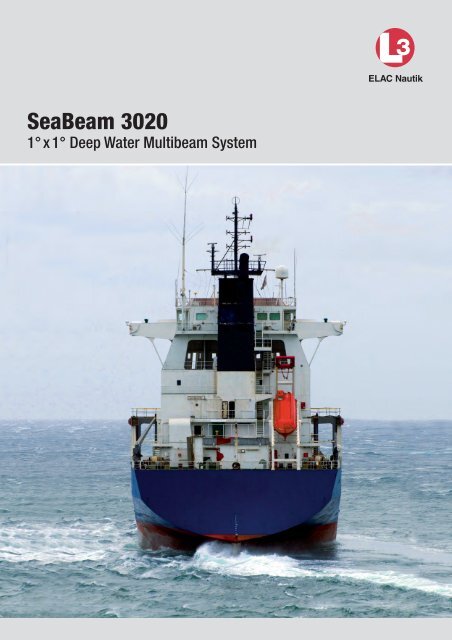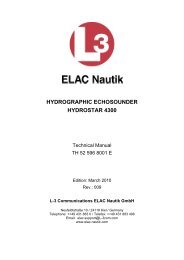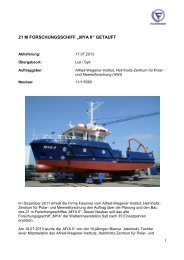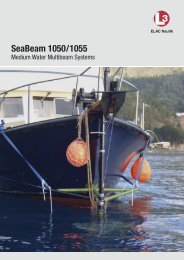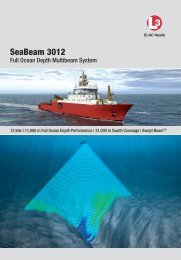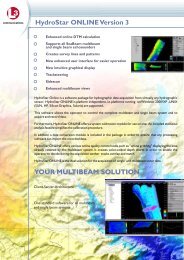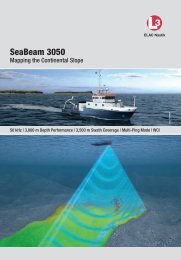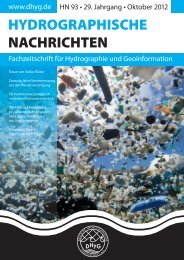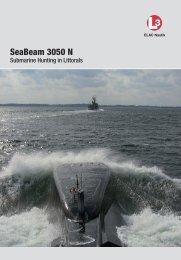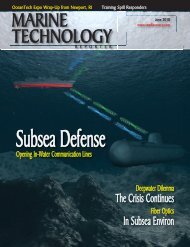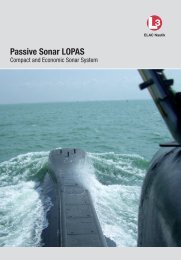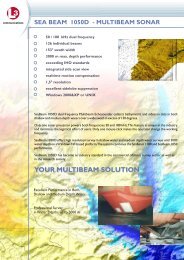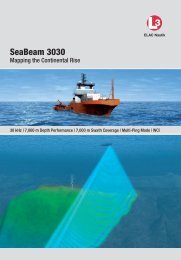SeaBeam 3020 - Elac-Nautik
SeaBeam 3020 - Elac-Nautik
SeaBeam 3020 - Elac-Nautik
Create successful ePaper yourself
Turn your PDF publications into a flip-book with our unique Google optimized e-Paper software.
<strong>SeaBeam</strong> <strong>3020</strong><br />
1° x 1° Deep Water Multibeam System
DISCOVER THE UNKNOWN<br />
<strong>SeaBeam</strong> <strong>3020</strong><br />
1° x 1° Deep Water Multibeam System<br />
<strong>SeaBeam</strong> <strong>3020</strong> is the latest generation bathymetric multibeam system from L-3 ELAC <strong>Nautik</strong>. This<br />
advanced system features the patented, revolutionary transmission technique called Swept Beam,<br />
which compensates fully for vessel pitch, roll and yaw motion.<br />
Performance<br />
<strong>SeaBeam</strong> <strong>3020</strong> is a high performance deep sea echo<br />
sounder, providing excellent bathymetric, bottom<br />
backscatter and side scan data due to its innovative sonar<br />
processing. The system operates at 20 kHz in water<br />
depths ranging from 50 m to more than 9,000 m, at<br />
survey speeds of up to 12 knots. <strong>SeaBeam</strong> <strong>3020</strong> produces<br />
bathymetric data that exceed the requirements<br />
of the International Standards Organization (IHO) for<br />
depths greater than 100 meters.<br />
(a)<br />
(b)<br />
(c)<br />
Vessel track without stabilization (a), with sector scan (b) and using Swept Beam (c)<br />
Swept Beam transmission technique<br />
The main difference between the Swept Beam and a<br />
classical sector scan (separately steered beams) is that<br />
the resulting swath footprints of the swept beams for a<br />
series of pings are evenly parallel spaced lines without<br />
any discontinuities.<br />
High density mode<br />
<strong>SeaBeam</strong> <strong>3020</strong> has 301 beams (maximum at equiangular mode). The swath can<br />
be decreased. The number of beams will be constant even if the swath width will<br />
be decreased until a specific angle is reached.<br />
Instead the sector scan produces a couple of hyperbolic<br />
curves with overlapping areas in the across-ship<br />
direction. These hyperbolic curves and overlapping areas<br />
produce some discontinuities which may generate<br />
artifacts in the post-processing.<br />
Key Features<br />
Patented Swept Beam technology<br />
> 9,000 m depth performance<br />
Compact design for off keel mounting<br />
3D drawings of 20 kHz hydrophone array (left), hydrophone and projector modules (right)<br />
2
<strong>SeaBeam</strong> <strong>3020</strong><br />
System Overview<br />
Compact Design for Flexible Installation Solutions<br />
Transmitter and receiver control units<br />
The transmitter control unit supplies the drive signals to the entire projector array.<br />
Each output is separately controlled for power level, phase and frequency. This<br />
faciliates programmable shading and steering as well as transmit beam stabilization<br />
using Swept Beam.<br />
The receiver control unit controls the overall ping cycle. It contains the receiver<br />
circuits for the hydrophones as well as the signal processor for beam forming,<br />
bottom detection and data reduction. The control units are interfaced to the operator<br />
station via Ethernet.<br />
Water Column Imaging workstation (optional)<br />
The Water Column Imaging (WCI) functionality is utilized<br />
via an additional PC workstation that logs WCI data and<br />
displays real-time images of backscatter from the water<br />
column and sea floor, both below and to the sides of the<br />
vessel. The WCI workstation connects to the <strong>SeaBeam</strong><br />
<strong>3020</strong> multibeam system via Ethernet and receives data<br />
for each ping from the multibeam.<br />
Transducer array<br />
The transducer array incorporates a projector and a hydrophone array in mills<br />
cross configuration. The 20 kHz projector array has an along track beam width<br />
of 1°. It consists of 25 identical modules. The projectors use Tonpilz resonators.<br />
The hydrophone array has an athwart ship beam width of 1° normal to the array.<br />
It consists of 15 identical hydrophone modules. These hydrophone modules use<br />
ceramic elements with broadband performance to provide excellent phase uniformity<br />
across the array and multi-frequency capability.<br />
Operator station<br />
The operator station, a PC of latest technology, provides a graphical user interface<br />
on high resolution TFT monitors for controlling the system using L-3 ELAC<br />
<strong>Nautik</strong>'s HydroStar ONLINE software. It communicates with the sonar electronics<br />
via Ethernet both for sonar control and reception of sonar data. It performs the<br />
sound velocity correction, heave compensation, navigation merging and data record<br />
construction. A variety of real-time data displays are available for quality<br />
control.<br />
3
SB 3050 l SB 3030 l SB <strong>3020</strong> l SB 3012<br />
Specifications and Technical Data<br />
<strong>SeaBeam</strong> <strong>3020</strong> at a Glance<br />
Technical Data<br />
Operating frequency<br />
20 kHz band<br />
min. depth<br />
50 m below transducers<br />
max. depth<br />
> 9,000 m<br />
Along-ship beam width<br />
(-3 dB points)<br />
1° (other beam widths available)<br />
Across-ship beam width<br />
(-3 dB points)<br />
1° (other beam widths available)<br />
Pulse length<br />
1 ms - 20ms<br />
Pulse length modes<br />
Manual and automatic<br />
max. swath coverage sector 140°<br />
max. swath coverage approx. 10,000 m (depending on<br />
own noise of the ship and sea state)<br />
Swath coverage modes Manual and automatic<br />
max. number of beams 301<br />
Beam spacing<br />
Depth accuracy (sonar sensor)<br />
Equidistance or equiangular<br />
In accordance with IHO for depths<br />
greater than 100 meters<br />
Interfaces<br />
Power<br />
Heave, roll, pitch<br />
Heading<br />
Position<br />
Surface sound velocity<br />
Sound velocity profile<br />
Stabilization<br />
Roll ± 10°<br />
Pitch ± 7°<br />
Yaw ± 5°<br />
115 V / 60 Hz or 230 V / 50 Hz<br />
single phase<br />
RS232<br />
RS232<br />
RS232<br />
RS232<br />
RS232<br />
Physical Specifications<br />
Length (mm) Width (mm) Depth (mm) Weight (kg)<br />
Hydrophone array 1°* 700 4,739 159 937 (without cable)<br />
Projector array 1°* 5,336 850 238 1,619 (without cable)<br />
Hydrophone junction box 726 600 191 45<br />
Projector junction box 409 640 130 29<br />
Receiver control unit 1,952 608 858 approx. 300<br />
Transmitter control unit 1,952 608 858 350<br />
*Dimensions may change due to special installation requirements. Please ask for dimensional drawings.<br />
L-3 Communications ELAC <strong>Nautik</strong> GmbH | Neufeldtstrasse 10 | 24118 Kiel | Germany | Tel. +49 (0)431-883 0 | Fax +49 (0)431-883 496<br />
elac.marketing@L-3com.com | www.elac-nautik.de | Design changes and errors reserved. Rev. A 28/11/2011<br />
4


